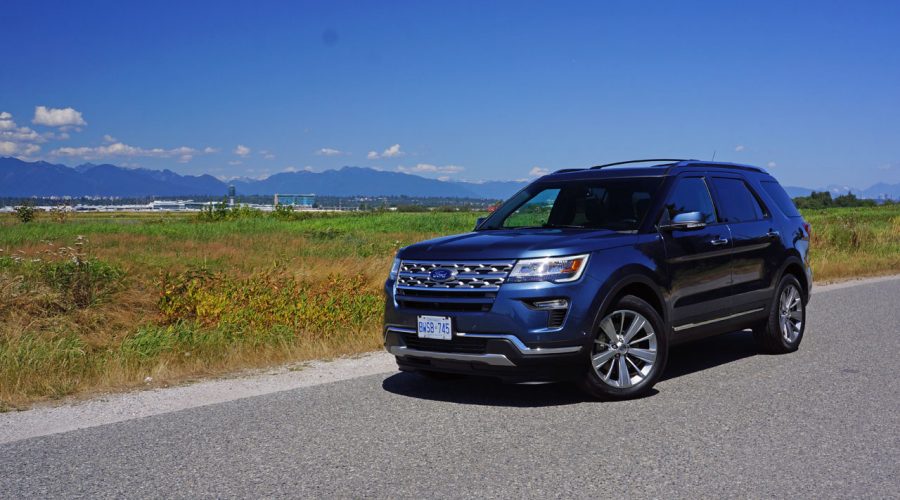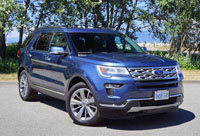
If you like the current Ford Explorer, or more accurately the outgoing Explorer, now is the time to act. The version I’m referring to is the unabashedly Range Rover-inspired fifth-generation introduced in 2010 for the 2011 model year, and it’s now being replaced by an entirely new 2020 model that’s quickly making this well-seasoned SUV sort of forgettable, just like most ground-up redesigns of decade-old vehicles do.
Let’s be reasonable, the sport utility on this page isn’t exactly a spring chicken, so it was beyond time to send it to pasture. What’s more, it rides on the Ford D4 platform that dates back to the 2004 Five Hundred/Taurus family sedan (a low point for the once-great designer J Mays, the Five Hundred looking geriatric when it was brand knew) and 2007 Freestyle/Taurus X (I was on the private Five Hundred unveiling as part of a Mercury event, and the Five Hundred and Freestyle launch trips), and that D4 architecture actually dates back to the 1999 Volvo S80 (P2 architecture), introduced the year before (Ford purchased Volvo in 1999). The D4 has served blue oval product planners very well since then, underpinning a couple of US-only Mercurys (RIP), the Lincoln MKS and MKT, and Ford’s Flex.
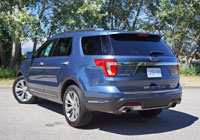
Despite its age the 2019 Explorer remains a very handsome and mostly up-to-date SUV. As its styling has developed over the years, it has taken on more Ford DNA and eschewed its once copycat Range Rover look, which is a good thing as it was important for the American brand to proudly display its own identity rather than aping a premium image pulled from a brand once owned. I particularly like the look of this Limited model, as it’s chrome-enhanced exterior features large 20-inch alloys and plenty of other styling upgrades, yet it’s still less optioned out when compared to its pricier siblings, making its design ideally clean and elegant.
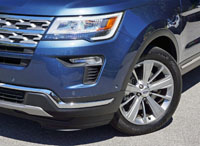
This generation of Explorer has served Ford and ultimately its loyal owner base well throughout its nine-year tenure, with a number of exterior styling updates, new powertrains, and improved infotainment interfaces keeping it fresh and modern. Every time I spend a week with one I’m reminded why it’s so incredibly popular, with Canadian sales consistently in the top three or four amongst mid-size SUVs and number one as far as three-row entries go, but despite looking good, delivering strong performance, and providing all the features buyers in this class expect, it’s starting to show its age in other ways, particularly some of the rubberized soft-touch and harder composite materials chosen inside.
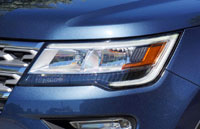
The 2019 Explorer shown on this page looks identical to last year’s refreshed 2018 model, that version a subtler styling update of the more comprehensive 2016 mid-cycle makeover. Of course, Ford changed up the wheels and plenty of features since then, but it’s pretty much the same under the skin.
Three engines are available, starting with Ford’s standard 2.3-litre Ecoboost that makes a healthy 280 horsepower and 310 lb-ft of torque, this turbocharged four-cylinder followed up by a 3.5-litre Ti-VCT V6 good for 290 horsepower and 255 lb-ft of torque for $1,000 extra (interestingly the opposite of last year’s powertrain lineup that made this comparatively old-school V6 standard), its advantage being towing capacity that moves up from 2,000 pounds standard and 3,000 lbs maximum (907 and 1,360 kilos), depending on the inclusion of its Class II tow package or not, to 2,000 and 5,000 lbs (907 and 2,268 kilos), the latter with its Class III trailering upgrade, which are the same tow ratings given to the top-line turbocharged 3.5-litre Ecoboost that turns this family workhorse into a fiery thoroughbred thanks to 365 horsepower and 350 lb-ft of torque.
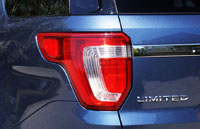
My tester was trimmed out in $46,034 Limited grade, one above the new base XLT that now starts at $39,448 (last year’s no-name front-drive base model is history, along with its more affordable $34,899 entry price), these two versions offering the first two engine choices, whereas $49,683 Sport and $55,379 Platinum trims come solely with the more formidable powertrain (check out CarCostCanada for all 2019 Ford Explorer pricing including trims, packages and individual options, plus available rebates and dealer invoice pricing that could save you thousands).

Fortunately for me and my wallet Ford left my tester with its base powertrain, its standard engine providing good economy at 13.1 L/100km in the city, 9.2 on the highway and 11.4 combined, which is great for such a large, capable and powerful SUV, and much better than the normally aspirated V6 engine’s rating of 14.5 city, 10.6 highway and 12.7 combined, and infinitely easier on the budget than the V6 Ecoboost’s V8-like 15.2, 10.9 and 13.2 respectively. You’ll need to fill it with 93-octane premium fuel to achieve those numbers with both Ecoboost engines, by the way, but not so with the lesser V6, so real-life running costs between the base and mid-range engines are probably very close.
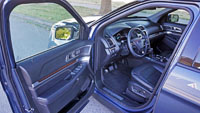
Before you start comparing the Explorer’s base fuel economy with its challengers you’ll need to factor in that this SUV now comes standard with Ford’s Intelligent 4WD, not front-wheel drive like it used to in Canada, and most competitors still do. Along with its standard 4WD, the Explorer also features the domestic brand’s Range Rover-like Terrain System that manages all types of on- and off-road surfaces, simply by its driver turning a console-mounted dial. Not a serious 4×4 like Ford’s own full-size Expedition, the Explorer nevertheless is quite capable over light- and even medium-duty trails by using its Snow, Gravel, Grass Mode, Sand Mode, or Mud, Rut Mode terrain management selections, optimized by standard Hill Descent Control and the SUV’s regular traction and stability control systems, while default Normal Mode is optimal for everyday use.
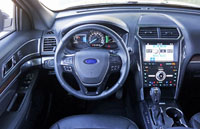
Off-road capability in mind, the Explorer rides higher than most crossover SUVs in the mid-size segment, feeling more like a true truck-based utility, yet as mentioned earlier in this review it’s based on a regular unibody platform architecture. This helps it maintain a tight, rigid body structure, something that’s noticeable as soon as bumps, dips and other road surface irregularities try to impede forward momentum, the result of Ford’s fine tuning over the years, as well as its inherently stable independent front strut and rear multi-link suspension design that comes complete with a 32-mm stabilizer bar up front and a 22-mm one in the rear, all providing an excellent balance of ride quality and handling.
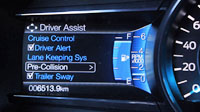
The as-tested Explorer Limited is no lightweight, hitting the scales at 2,066 kg (4,556 lbs) despite only harnessing its base 2.3-litre Ecoboost, but the previously noted thrust and twist figures make for a powerful punch off the line, and the sole six-speed automatic transmission is certainly a good match to the engine, not to mention much more proven than all the new eight-, nine- and even 10-speed autoboxes showing up on the market these days; the redesigned 2020 Explorer getting the latter. I found the six-speed shifted smoothly and positively, aided by a thumb rocker switch on the shift knob for manual mode, and therefore I’d have no problem with its performance for reliability tradeoff.
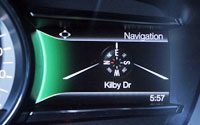
Comfort is one of the Explorer’s greatest assets, and it comes with room to spare. It seats seven in standard trim or six with its second-row captain’s chairs, the latter providing an easy passageway for kids to climb through, which can be helpful if you’ve got a child strapped into a booster or safety seat. My tester seated three abreast comfortably in the second row, the outboard positions benefiting from two-way heatable cushions with switchgear located on the backside of the front centre console next to a manual HVAC interface, two USB charge ports and a three-prong household-style 110-volt socket, while each 60/40-split side of seats flip forward almost completely out of the way when needing to access the third row. The two rearmost passengers should be comfortable enough unless particularly tall, with my five-foot-eight frame finding room enough in all directions.
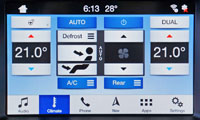
Those 50/50 split folding third-row seats can be lowered into the deep luggage well via available power controls on the cargo wall, and they stow much like they would in a high-end minivan (something Ford no longer sells), while the second-row seats need to be manually lowered via the rear side doors. When completely laid flat the Explorer’s cargo capacity expands from 595 litres (21.0 cubic feet) behind the third row, or 1,240 litres (43.9 cubic feet) behind the second row, to a maximum of 2,313 litres (81.7 cubic feet) behind the first row. That’s pretty sizeable, and easily on par with most three-row competitors.
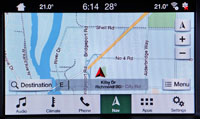
Back up front, the Explorer Limited’s 10-way powered driver’s seat should be comfortable for the majority of body types, with a good inherent design and plenty of adjustments including four-way powered lumbar support and memory. The powered steering column provides plenty of reach, which allowed me to set up my driving position for optimal comfort and control, while the majority of buttons, knobs and switches across the instrument panel and console were within easy reach.
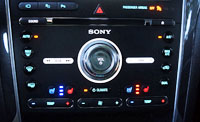
The centre touchscreen comes filled with Ford’s excellent Sync 3 infotainment interface. Its white and black (and sometimes maroon) on light blue graphics continue to look fresh and attractive, and it remains fairly fast reacting if not the highest in resolution compared to some newer systems in more recently updated models offered by competitors as well as Ford itself, such as the new 2020 Explorer. Still, despite its matte display, which helps limit fingerprint smudges, it’s bright and clear, unlike some rival interfaces that are so washed out you can’t see any details on a sunny day due to glare. For instance, I found it near impossible to read a 2019 Toyota Highlander’s centre display in certain lighting conditions (which incidentally was not yet equipped with Toyota’s latest Entune system), and it became even worse when wearing my polarized sunglasses. In the Explorer this is not a problem.
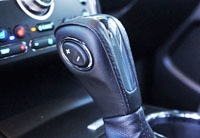
The quality of all Explorer switchgear is certainly up to par with others this class too, some of it actually quite special. The rotating audio dial, for instance, features knurled metal-look edging that gives it a premium appearance and feel, while I was also impressed with the woodgrain trim’s density, this spanning the dash and each door panel, and I love the way the satin-finish aluminum accents wrap around the wood before butting up against each piece of door trim. It would’ve been better if said sections of decorative dash and door inlays matched up with each other, these pieces not aligned properly during assembly (see photos 28 and 29 in the gallery), but Ford should get kudos for the quality of materials and overall design just the same (you can request that your dealer properly hangs the doors at the point of sale, so all the interior trim bits line up better).

The woodgrain and metallic trim is standard, while over and above features already mentioned the base XLT also comes with LED signature lighting around the otherwise automatic LED low-beam headlamps, plus LED fog lamps, LED taillights, 18-inch alloy wheels on 245/60 all-season tires, silver roof rails, Ford’s Easy Fuel capless refueling filler, remote engine start, proximity keyless access with pushbutton ignition, Ford’s SecuriCode entry keypad, MyKey, forward and reverse parking sensors, a leather-wrapped multi-function steering wheel, a leather-clad shift knob, an eight-way powered driver’s seat, heated front seats, an auto-dimming rearview mirror, Ford’s Sync 3 infotainment with a rearview camera, seven-speaker AM/FM/MP3 audio with satellite radio, FordPass Connect with a Wi-Fi Hotspot, a media hub with a smart-charging USB and four 12-volt power points (two in the first row, one in the second row, and one in the cargo area), filtered dual-zone automatic temperature control, blind spot monitoring with rear cross-traffic alert, and much more.
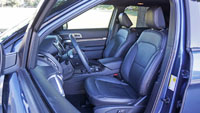
Also standard is an amply strong body shell and enough safety equipment to achieve an NHTSA 5-star crash safety rating, while Ford also offers a new (last year) $1,000 Safe and Smart Package that includes rain-sensing wipers, automatic high beams, adaptive cruise control, forward collision warning with brake support, and lane-keeping assist.
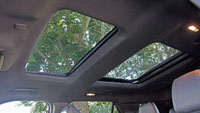
Ford added the Safe and Smart Package to my Limited tester, which otherwise gets upgraded with a fair bit of extra chrome trim outside, two-inch larger 20-inch alloys on 255/50 rubber, power-folding side mirrors with integrated LED turn signals, ambient interior lighting, a heatable steering wheel rim, a powered tilt and telescopic steering column, a universal garage door opener, standard perforated leather upholstery featuring three-way forced ventilation and memory (that also controls the mirrors and steering column), a 10-way powered front passenger seat, a 180-degree split-view front parking camera, voice-activated navigation with SiriusXM Traffic and Travel Link, a hands-free foot-activated powered liftgate, great sounding 12-speaker Sony audio, the 110-volt AC power outlet, heated second-row seats, and power-folding third row I mentioned earlier, plus Ford added a $1,750 dual-pane powered panoramic sunroof overhead, all of which kept this particular Explorer below the $50k threshold, including its destination charge.
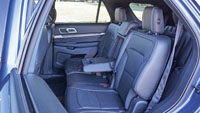
Plenty of additional options and packages are available, including a $1,500 XLT Desert Copper Package that adds special 20-inch alloys, chromed side mirrors, and black/copper leather upholstery to the entry-level XLT trim; plus the $1,600 XLT Sport Appearance Package with special “EXPLORER” block lettering on the lip of the hood, unique Magnetic Metallic-painted (black) 20-inch rims, additional exterior accents painted in the Magnetic Metallic hue, black roof rails, “EXPLORER” embroidered front floor mats, special door trim panels with Fire Orange contrast stitching, exclusive black leather upholstery with perforated Miko inserts, Foxfire scrim and the same Fire Orange contrast stitching, etcetera.
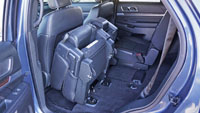
My Limited tester could have included a $2,900 301A package that includes the Safe and Smart Package plus a set of Multicontour front seats with Active Motion massage, enhanced active park assist, and exclusive inflatable rear outboard safety belts.
As for aforementioned Sport trim, the much more powerful and notably sophisticated looking model replaces any exterior chrome with high-gloss black trim, including the mirror caps and door handles, plus adds a unique blackout treatment to the headlamps and taillights, while also adding its own set of black 20-inch alloys, upgrades the cabin to include perforated leather seating with red stitching and an enhanced Sony audio system with Clear Phase and Live Acoustics, while including all of the Limited trim’s features as well as the Safe and Smart Package as standard.
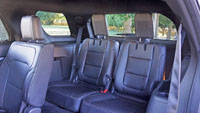
Lastly, top-tier Platinum trim includes everything already mentioned except for replacing all of the black trim with satin-chrome silver and adding a set of quad tailpipes to its backside, this variation on the Explorer theme being the most Range Rover-esque from a design perspective, but nevertheless a very sharp looking family hauler. The Explorer Platinum also makes the twin-panel moonroof standard, adds power-adjustable foot pedals and active park assist, plus upgrades the interior with Ash Swirl hardwood trim bordered by genuine aluminum accents as well as rich Nirvana (not the band) leather upholstery featuring micro-perforations and quilted bolsters. Also included are the massaging Multicontour front seats from the previously noted 301A package, an upgraded instrument cluster, a leather-covered instrument panel and door uppers, more leather over the door and centre console armrests, a special headliner, and active noise reduction.
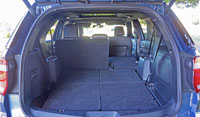
Certainly the Platinum would’ve been a nicer ride than my Limited-trimmed tester, but for about $6k less it was still very good looking, enjoyable to drive, fuel-efficient, loaded with luxury features, incredibly accommodating from front to back, and pretty well finished inside, give or take a couple of unaligned trim bits.
All in all the outgoing 2019 Explorer is still a great three-row SUV that no doubt can be had for quite a bargain now that it’s life-cycle is ending and an all-new Explorer is in the midst of launching.

